Blog Archives
What Happened Today at the Monastery?

Sadhu Paksha: Day Eleven
It’s very quiet at home. With Bodhinatha traveling with Sadhaka Dandapani and also Palaniswami and Arumugaswami… all four of whom are now in New Jersey… we are running on a “short crew” here at the Aadheenam. Though there are no tours… the August vacation season is bringing lots and lots of visitors to the temple in the morning.
Sadhaka Dandapani has sent these photos from New Jersey yesterday… catching up with events in Edmonton, Canada, and the first day in New Jersey where Bodhinatha joined the “Hindu Encyclopedia” working group to discuss that project, before continuing on the next day with the main event: the Dharma Conference… more about that below…

Senthilathiban is here from India, having brought over the latest silpis crew. He climb up to the roof of Iraivan and took these shots…
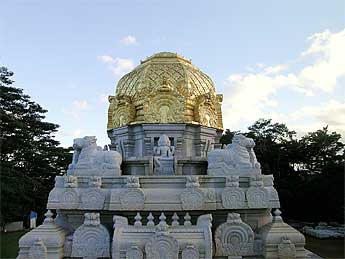
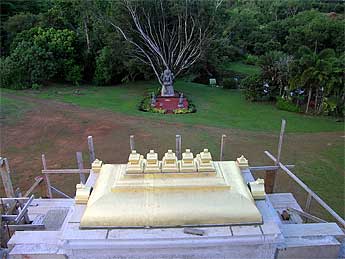
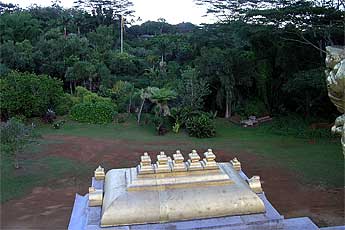
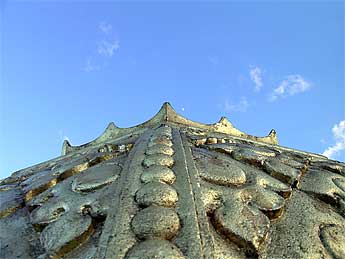
The full moon in the background… look up over the vimanam…

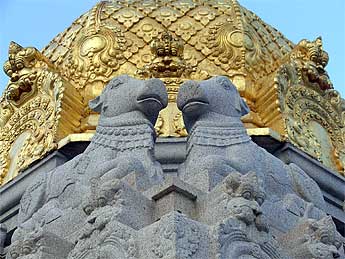
Bodhinatha in Edmonton
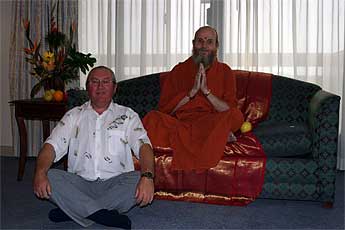
August 10th (Edmonton): Bodhinatha’s day started with meetings with devotees. First up was Jnanideva Cevvel who was on the 2004 Indian Odyssey Innersearch with Bodhinatha.
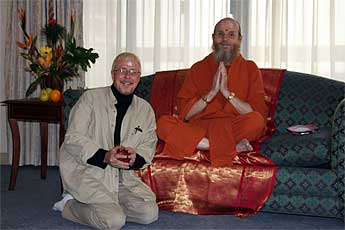
with Nitya Sivam.

Rajesh Bali and family. Rajesh was the one who organized the wonderful event with the Fijian Hindu community the previous night and invited Bodhinatha to return again next year.

Vaidya Bala meets with Bodhinatha.

He teaches the Tirukural to the young children in the Saiva Dharma class whom you all saw on TAKA a few days ago.

Sivajnanam and wife meets with Bodhinatha. They are long time devotees of Gurudeva and Sivajnanam is the one that maintains the Gurudeva shrine in the Maha Ganapati temple.

Saravan and Bhavani Veylan.
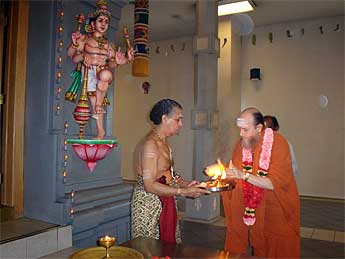
Later that evening Bodhinatha attended the abhishegam and puja at the Maha Ganapati temple. It is a beautiful and powerful temple with Maha Ganapati’s presence strongly felt.
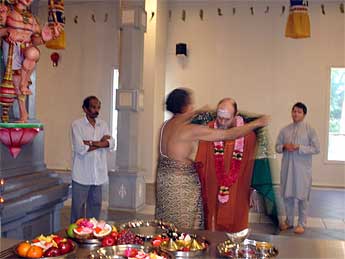
Subramania Kurukkal presents Bodhinatha with a shawl after the puja.

The temple is really well maintained by a group of dedicated devotees who keep it spotlessly clean, grow flowers and vegetables in the temple garden and maintain firmly the temple traditions the traditional way. Congratulations to all of you for setting a wonderful example for everyone!

After the puja Bodhinatha headed downstairs to the cultural hall to give a talk titled “Work is Worship”.

On the northeast corner of the hall is a shrine dedicated to Gurudeva who presented the community with a Ganesha many years ago to begin the worship and guided the community in the establishing of the temple.

One of the temple trustees thanks Bodhinatha for coming to the temple.

Tara Veylan comes up for vibhuthi blessing.


Subramania Kurukkal is from Alaveddy, in northern Sri Lanka and we’ve known him for many, many years. He has been the priest here at the Maha Ganapati temple for 18 years now.
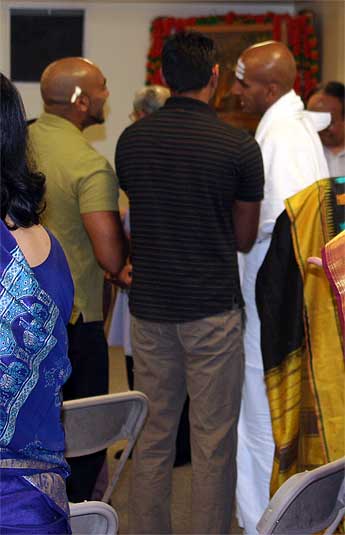
Sadhaka Dandapani takes a moment to talk to Sivajnanam’s sons.

Mr. Selvarajah, another long time devotee of Gurudeva, telling his son, Mayooran, that he should visit Kauai Aadheenam.

The photo on the right shows Gurudeva blessing the spot where Ganesha is right now. Here’s the story of that sacred event. About 20 years ago the community purchased a 5-acre plot of land. The parcel was undevelo
ped and covered with bush. They invited Gurudeva to come and bless the land. Gurudeva walked around the property among the shrub and came to a location which he identified to be the exact spot where Ganesha will be placed and worshipped when the temple construction is complete many years later. He then blessed the spot, did a small abhishekam (as seen on the photo on the wall), followed by arathi and then prostrated on the ground.
Bodhinatha Goes to New Jersey

August 11th: After 12 continuous hours of being in cars, airport lounges and planes Bodhinatha made it from Edmonton to New Jersey.

August 12th (New Jersey): On this morning Bodhinatha attended the last day of the Encyclopedia of Hinduism Conference hosted by Swami Chidananda Saraswati.

Bodhinatha addressing the scholars present.

Swami Chidananda presents Bodhinatha with a shawl.

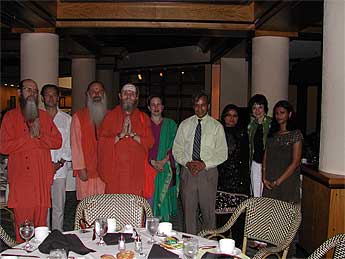
Later that evening just before Bodhinatha headed out to another temple visit he stopped briefly in the hotel restaurant to meet with some devotees. Among them are Mark and Lindsay Boyer who drove down from New York and Julie Rajan, who writes for Hinduism Today.
There is Paramacharya Palaniswami and Sannyasin Arumugaswami who have come to represent Hinduism Today at the Dharma Conference…

Then Bodhinatha was taken to the Sri Venkateswara temple in Bridgewater, New Jersey.

Dr. Shirish Parekh leads Bodhinatha to the temple entrance. It is a beautiful, large traditional South Indian style temple set on a 10 acre parcel.

Sharad Trivedi who visited Kauai with his family last year welcomes Bodhinatha.

The gopuram is tall and spectacular making you feel like you are walking into a temple in south India.

The temple has 10 full time priests – some Vaishnava and some Saiva. The main Venkateswara deity in the sanctum is about 10 feet tall from base to top.

After the puja Bodhinatha was led to a classroom in the basement section of the temple to give a talk.

A small group of devotees, some traveling 3 hours from New York and Pennsylvania, came to spend some rare time with Bodhinatha and hear him talk.

Shirish and Daksha Parekh who did a wonderful job in organizing this evening’s events.
Tomorrow we will bring you photos from the first day of the Dharma Summit Conference. But just now… an email has arrived from Arumugaswami with the first installment of a report:
“There was a wide representation of Hindu leaders and institutions, including Swami Dayananda Saraswati, Swami Chidananda Saraswati (Muniji), Swami Jyotirmayananda (our old friend from Tamil Nadu), Sudarshan, head of the RSS in India, BAPS, Hindu-American Foundation, Hindu Student Council, Barsana Dham, the Brahma Kumaris, and more, 80 institutions represented in all. There were 400 participants, which was more than capacity and they turned away more. The days were long throughout the sessions, 7:30am breakfast gathering, 9 am starting of the formal session which went on to 9:30 or 10 pm, with breakfast, lunch and dinner served at the conference venue at the Student Center at Rutgers College (one of the oldest colleges in America, founded by none other than Benjamin Franklin in 1766, a red brick college near a river, in a 350-year-old town.)
The main concern and stated purpose of the historic Dharma Summit was the transmission of Hinduism to the second generation of America-born Hindus, with a secondary goal of creating an assembly of noted and authoritative groups and individuals who can speak, in a one voice, to the peoples of America on behalf of the two plus million Hindus in the country. Special prominence was given to the role Hindu temples can play in this, the importance of the example of parents, various tools and methods for use with children’s classes. The attempts of Hindus to alter the text books now being taught in American schools and university with chapters on Hinduism was addressed several times. There is a major initiative to remove from those books the many misconceptions that still persist today when scholars discuss Hindu religion and culture. Progress is being made on this front and Hinduism Today plans to publish an article on this interesting and complex subject, with the help of young Hindus we met here.
Bodhinatha gave the first evening keynote speech, explaining how parents need to set the example and teach Hinduism in the home, especially by the worship in the home shrine. His information-and-art-rich presentation was well received and appreciated. As Bodhinatha left the stage one of the leaders of the Vishva Hindu Parishad eagerly came forward, asked if this Keynote tool could be sent to him digitally, which he wants to send out to a list of 4,000 VHP members across America. He loved it and saw the potential to help Hindus. Swami Jothirmayananda was excited about the possibility of putting his Swami Vivekananda biography into Keynote format. Bodhinatha’s talk was still being discussed in the days after his departure. One Hindu college student found the four sects map of Hinduism to be the clearest understanding she ever had of her faith.
More tomorrow on the New Jersey Dharma Summit and Hinduism Today’s participation and assessment.
Below we share with you the preliminary pre-conference draft of objectives for the meetings to help give some background on the event.
Dharma Summit 2005
will be held on August 13,14,15
at Rutgers University, Student Center,
126 College Avenue, New Brunswick, NJ.
The objective of this conference is to bring together heads of all Devalayas, spiritual institutions, and Dh
armic intellectuals in North America to exchange thoughts and ideas, and share experiences on how to impart spiritual and cultural education to our next generation and remove misperceptions about our faith traditions from the society in order to maintain our Dharmic traditions with dignity.
This conference is being organized with the support, cooperation and involvement of all major Sampradayas and institutions. The summit will bring together on one platform heads of various Sampradayas: Swami Dayananda Saraswati of Arsha Vidya Gurukulam, PA; Swami Chidananda Saraswati (Muni ji) of Parmarth Niketan, Rishikesh, India; Satguru Bodhinatha of Hindu Monastery of Kauai, Hawaii; Gurudev Chitrabhanu of Jain Ashram, NY; Dr Pranav Pandya of Gayatri Pariwar, Haridwar, India, Swami Jyotirmayananda of Vivekananda Center, Mangalore, and others. Also many intellectuals will speak in various sessions: Dr. Ved Nanda, Prof Bhudev Sharma, Dr David Frawley, Dr Piyush Agrawal, Sri Bawa Jain, Sri Kanchan Banerji, Dr Rakesh Shreedhar, Assemblyman Upendra Chivukula, and many others.
All past, present and future presidents, founders, Board members, and youth program coordinators of all Hindu, Jain temples and Gurudwaras are invited. Some of our religious institutions have done an excellent job of training the young people. We can network, interact and learn from the successful experiences of one another in a mutually supportive environment in this conference.
These intellectuals will discuss the future of Dharma in North America. How can our young generation grow with the best values from both cultures? How can they learn the true meaning and concepts of Dharma and take pride in their heritage? Two sessions on Monday Aug 15 will present a workshop on Temple Management Administration for the benefit of the Temple Board members.
Our young generation does not have the opportunity to learn about our traditions from grandparents, aunts, uncles, and older siblings, or festivals and neighborhood celebrations, as we did growing up in India. They learn distorted versions of our faith, culture and traditions from their teachers and textbooks in schools and colleges. Even highly reputed and world-class reference books like the Microsoft Encarta encyclopedia have presented a distorted and maligned image of Hinduism.
They are influenced by TV and internet. Unfortunately, the media tends to present mostly the sensational and bizarre stories about Hinduism. As a result of negative stereotyping, our students feel embarrassed and ashamed with the classroom discussions on Hinduism; they feel alienated from their heritage (see “The Abuse Hinduism Receives In US Schools Is Intolerable” by Trisha Pasricha a 15-year old school girl from Houston, TX, about her experiences — scroll down the page to find her essay). Some of them develop resentment against Hinduism and Hindus, including their own parents and relatives. Some even find it necessary, or expedient, to convert to Christianity in order to succeed.
The accomplishments of our new generation in schools, colleges, and universities are commendable. However, most of them do not relate to the temples and gurudwaras we have so enthusiastically built. They tend to feel that these institutions hold no relevance in their lives.
Our religious institutions must focus on the needs of the new generation by organizing activities
for them and presenting the correct and positive aspects of our traditions; e.g., Yoga, meditation, religious tolerance, Ahimsa/non-violence, that continue to gain strong following and can play a major role in building a pluralistic and tolerant society in North America by virtue of our belief in “Ekam Sat Vipra Bahudha Vadanti” and “Vasudhaiva Kutumbakam”.
From Our Gurus' Teachings
Archives are now available through 2001. Light colored days have no posts. 1998-2001 coming later.
